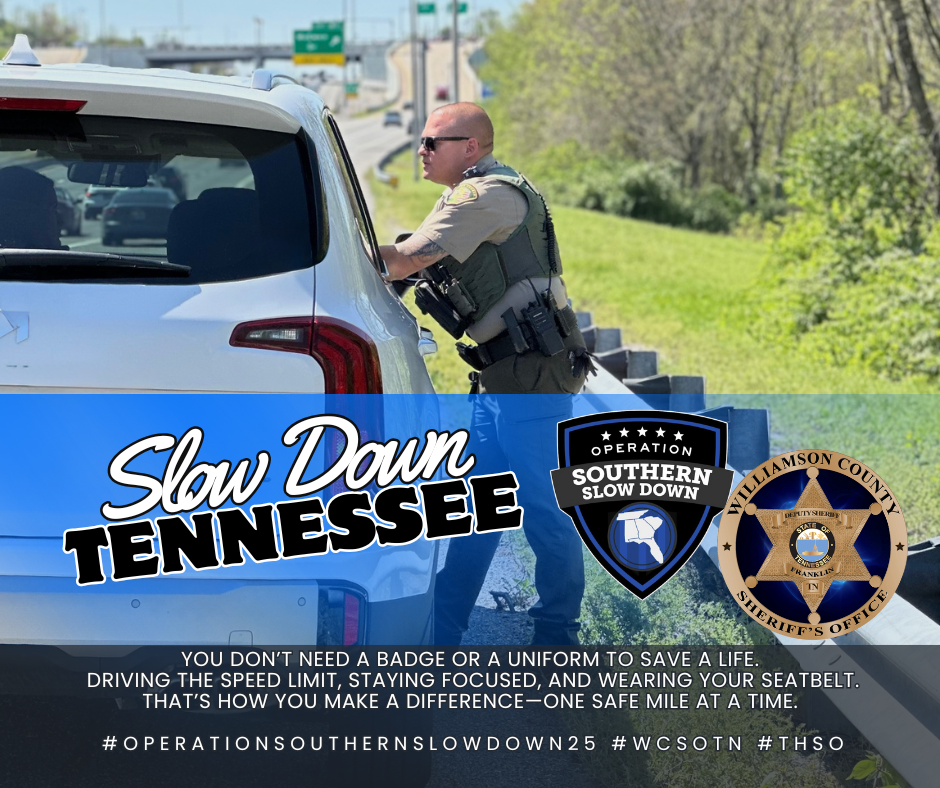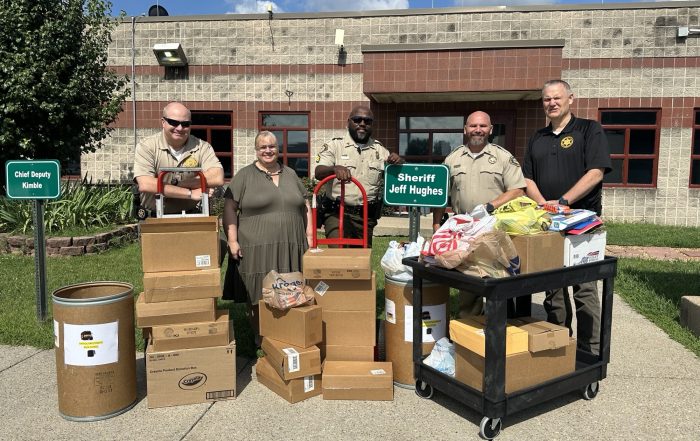History
WCSO Then and Now: 40+ Years of Growth
Each year we review photos we took and tucked away for posterity, and reflect on our past twelve months. We discuss our progress to date, and our future goals and objectives. It’s an opportunity to look at this organization from a bird’s eye view. It’s also made me contemplate how these days some of the deputies get a literal bird’s eye view of the sheriff’s office and the whole county – through the windows of our helicopters or through the eyes of a drone. This was unimaginable when I joined over 40 years ago.
My career in law enforcement began right here in Williamson County on June 1, 1979 under Sheriff Fleming Williams. Fleming was first elected sheriff in 1970, coming into law enforcement after a background in the oil business. This county had remained a rural community since the Civil War when several violent local battles gutted the younger population and damaged the economy. When Fleming came into office, Williamson’s population was just beginning to grow after nearly a century of stagnation. Friday night entertainment for the younger crowd was simply cruising up and down the square in downtown Franklin but countywide violent crime was rather high. Murder, robbery, and burglaries were more frequent. Alcohol contributed heavily to crime. There were a surprising number of whiskey stills and bootleggers. Small beer joints and clubs dotted the map where nasty fights would frequently break out. Many local markets sold alcohol illegally on Sundays or to the underage. Fleming took office with a mission to improve the community and a plan to build a reputation of integrity and professionalism for WCSO. There were term limits in place at the time, so in 1976 Fleming’s wife, Ophelia Williams, was elected sheriff for two years and Fleming served as her chief deputy. Fleming could then be re-elected as sheriff in 1978.
In mid-1979, the sheriff’s office and jail were on Bridge Street in Franklin. Although this jail no longer exists, the two jail buildings prior to it still stand nearby on Bridge Street today. This jail was a small, one story red brick building built in 1971 that had four “drunk tanks” and usually housed about 40-50 inmates with one jailer to guard them. Sgt. James Lankford, “Hun” Crowder, and Charles “Big Daddy” Pope were the regular day, evening, and night jailers. The sheriff’s office was a small group – less than two dozen for sure. When Fleming hired this young man from West Tennessee, he assigned me to day shift patrol to work staggered ten-hour shifts, five days a week along with Deputy Garland Russell and Sgt. James Lane (Lane pulled double duty serving state warrants and patrolling with us). Roddy Parker served civil warrants. Three other deputies worked night shift patrol. With our staggered schedules, there would be just one lone officer protecting the entire county for a few wee hours of the morning. Captain John Easley was Fleming’s right hand man. Detectives Frankie Bryans and Tommy Atkinson handled investigations. Our support staff was one records/evidence clerk (Linda Ryan), a dispatcher (Elsie McCord), and Ophelia Williams who handled administrative duties, finances, and civil paperwork.
As a new deputy, there was no formal training. I shadowed on patrol for a single ten-hour shift that flew by and then it was off to patrol the streets on my own. Six weeks of training at the state’s TLETA academy would come the following spring. The office supplied essentially no equipment and bulletproof vests did not even exist. We had to provide our own guns, and my choice was a Smith and Wesson .357 revolver. We did not initially have take-home vehicles; they ran hot 24/7 as we hopped out of the driver’s seat and the next shift hopped in. I drove a Plymouth Satellite Sebring with one beacon light on each end and just an AM radio. However, the vehicle coveted by everyone else was Roddy Parker’s 1977 Dodge Monaco with an FM converter in it. Other day shifters would race to get to work early in hopes of snagging it for themselves. Deputies did not arrive late for their shift with that prize on the line. We would eventually get FM converters for the other cars too. One of my additional duties became equipping and maintaining our vehicles. We would add our own takedown lights using aftermarket fog lights from local stores, and when Fleming purchased us some new shotguns, we bought shotgun racks at the Standard Farm Store in Franklin and mounted them ourselves. Fleming was strict about keeping new equipment clean and in good working order. He was conscious of our reputation and the public’s faith in us. In fact, he even had a rule that if we wanted to go out for a drink off the clock we needed to do it in Nashville or another county. There would be no drinking or misbehaving from his own men in his own county.
My first big felony arrest came in August of 1981 for a cattle-rustling incident. Herbert and Agnes Nichols filed a report for two stolen calves worth $1,400. A call came in later that night saying the suspect vehicle may have returned to the area. We stopped a station wagon near Triune and found a little calf still in the backseat of that car. The thief, Joe Walsh, was also a Metro Nashville fire inspector and additional investigation at his farm found 46 other cows confirmed or suspected as stolen. They indicted him on eleven counts of larceny of cattle (he pled guilty to three counts), gave him fifteen years and sentenced him to serve two years in the pen.
Meanwhile, the department was expanding to combat crime. Between 1980 and 1981, I was promoted to patrol corporal and then patrol sergeant, and Fleming added personnel to the road and the jail that now held some 80-odd prisoners at a time. He also began a “One Man, One Car” program in early 1985, starting with five new vehicles to reduce maintenance needs and increase response times. Enter my first take-home patrol car: a 1980 Dodge Diplomat. Some of our newest cars had aerodynamic light bars. It was still my duty to outfit the vehicles and now I was stocking them with new cage styles with enhanced safety features, shotguns, Slim Jims for lockouts, first aid kits, blankets, and fire extinguishers. Next, the county approved seven more positions. Several went to patrol, one to warrants, and one to investigations, and Fleming promoted me to patrol lieutenant in July 1985, placing me in command of the field division.
Heading into the last years of the 80s, Williamson was growing and we were feeling the effects. The jail started regularly overcrowding and it was time to plan a new facility. We continued to add personnel at a rapid pace, now totaling about 85 employees between the patrol side and the jail. We were proactive on the streets, combating illegal sales by going undercover to buy whiskey or an illegal short-barreled shotgun, or maybe beer on Sunday. We occasionally got assistance from THP’s helicopter scanning Williamson County from the sky to report marijuana fields and whiskey still locations back to us on the ground. We had long patrolled the county in three established zones. Zone 1 in the north included Grassland and lands now annexed by Brentwood. Zone 2 was vast, ranging from Fairview along Hwy 96W, out to I-65 and down to Maury County. Zone 3 picked up from I-65 and covered the east end from Nolensville down through College Grove. Zone 3 would now split to create a Zone 4 in the southeast communities like Peytonsville, Flat Creek, and College Grove. The new layout plus more patrol deputies would speed response times and allow us to combat both a recent surge in armed robberies in the Goose Creek area and higher call volumes in Thompson’s Station after the Saturn plant migration. A 1986 change in federal law affecting first responders and overtime pay required even more personnel for a transition from five ten-hour shifts to five eight-hour shifts. There was a growing need for specialized units. Forward planning for a vice investigator and a tactical team were put in the works. The tac team would need training, bulletproof vests, tear gas and gas masks. In 1987, we trained and posted our very first school crossing guards at Grassland, Page, and Nolensville schools. In 1989, we moved into our newly built $7 million, 210-bed jail facility on Century Court.
A new decade brought a new elected sheriff for the first time in my career. Sheriff Lance Saylor headed our office from 1990-1994, which had grown to 115 employees to staff the larger jail facility. As a former director of the 21st Judicial Drug Task Force, he naturally brought a focus on drug enforcement, implementing D.A.R.E and S.T.A.R.S. programs for students, and participating in an interagency DUI task force. M.A.D.D. donated several video cameras for us to document drunk driving via the “Eye on DUI” program. That’s right folks, clunky, full size VHS recorders were now mounted in some patrol cars. In 1991, he appointed our first female patrol deputies, assigning Sharon Lambert to patrol, Melissa Brown to crime prevention and D.A.R.E., and Mary Lou Bartlett to state (criminal) warrants.
We initiated the Explorers program for our teens, and implemented an offender-based alcohol and drug treatment program in the jail for recovery and reduced recidivism. Our hiring process included a physical fitness and agility test for the first time. The Cool Springs Galleria had opened in Franklin, bringing growth, tourism, and traffic. By the mid-90s, it was necessary to restructure the patrol zones again, carving out parts of zones 2 and 4 to make a zone 5 from south of Franklin through Thompson’s Station and Burwood and down to the Maury County line.
Bill LeCates was elected sheriff in 1994 and carried us into the new millennium. He brought with him a focus on training and technology. By 2000, we had already expanded our jail capacity 100%, now housing 450 beds. Within a few years we would be approaching 200 employees across the divisions. Sheriff Ricky Headley served from 2002 to early 2007 and made community interaction and visibility a priority. He also restructured and expanded the command staff in late 2002, including promoting me to a newly established chief deputy position. Sections of I-840 began opening in our county, and we created an interstate crime interdiction unit of two deputies partnered with drug detection dogs. Patrol now had mobile data terminals (MDTs) mounted in their vehicles to display and log call information, and they started carrying AR-15 rifles in their vehicles. I served the office for a short period as interim sheriff during 2008 until our next sheriff would be chosen in a special mid-term election that year.
Sheriff Jeff Long had been with our sheriff’s office in the mid-70s before going on to serve in the district attorney’s office and with the TBI. Under Sheriff Long, we elevated the special operations division, breathing new life into repurposed government surplus equipment. A swift water rescue team was established after the May 2010 floods left Middle Tennessee scrambling. Responsive to the tragic Sandy Hook school shooting, he pushed for a major expansion of the school resource officer division to add over 30 SROs in the elementary schools. By 2015, we had over 250 total employees. In 2016, special operations incorporated helicopters for our use and as a mutual aid resource for surrounding agencies and counties. In 2018, the governor-elect appointed Jeff Long as Commissioner of the Tennessee Department of Safety and Homeland Security, and I was once again named interim sheriff until my own election later that year.
My aim as sheriff is to continuously improve and advance our office. Our mission statement is “to provide the citizens and visitors of Williamson County effective and efficient public safety services with consistency, professionalism, competence, and transparency”. In effort of that mission, I have implemented body worn cameras throughout the divisions, starting with patrol in 2019. Completing a three year, in-depth review of our policies and procedures ultimately awarded us accreditation by the Tennessee Law Enforcement Accreditation Program in 2020 and a reaccreditation in 2022. This is the third annual report released to the community to keep you informed. We have established the first crisis intervention team in the county, and added a mental health co-responder partnership to certain calls for service. Additionally, we are actively in the process of seeking a newly offered, enhanced Tier 1 TCI Accreditation for our detention facility. Consistency, professionalism, competence, and transparency.
June 1, 2023 starts my 45th year with this office. I am proud to simultaneously lead this agency and be its longest serving active employee. I’m fortunate that a handful of employees who joined around the same time I did are still here serving with me. Others are still active in law enforcement elsewhere, like Commissioner Jeff Long and Nolensville Police Chief Roddy Parker. But, as the saying goes, the more things change, the more they stay the same. We are always fighting to maintain competitive pay. We are always seeking technology that helps us do our jobs more efficiently and keep up with criminals’ innovation. Our local agencies still work together to solve crime, because criminals don’t care about jurisdictions. So yes, I think about that sheriff’s office of 1979 – a couple dozen employees in that small brick building with very little equipment or training but plenty of enthusiasm for the work. I think about the sheriff’s office – my office – of today: several hundred employees spread out among five buildings until the newly planned sheriff’s office and jail can be built. The new, larger jail will account for projected population growth in the area, and the new sheriff’s office will rejoin our personnel under one roof with space for admin offices, a K-9 training facility, an updated gun range, a helicopter launch pad, and a renovated special ops space. Today’s deputies drive safer vehicles equipped with dash cams, mapping, and MDTs. They use body cams, cell phones, Tasers, portable AEDs and other lifesaving equipment and medicine. They get good equipment. They get good training. And yes, they too, have enthusiasm for the work. I’m excited to see where we are today. I’m excited to see where we go tomorrow. I hope you are too!








